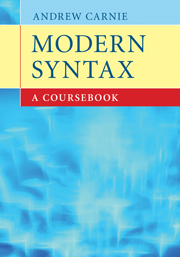Book contents
- Frontmatter
- Contents
- Acknowledgments
- How to use this book
- A note on the theoretical perspective of this book
- 1 Some basic ideas in syntax
- 2 Categories and subcategories
- 3 Constituents, MERGE and trees
- 4 Movement and control
- 5 Conclusions
- Appendix 1 Glossary, symbols and abbreviations
- Appendix 2 Features and their values
- Appendix 3 Rules, constraints and principles
- References
- Index
Appendix 1 - Glossary, symbols and abbreviations
Published online by Cambridge University Press: 05 June 2012
- Frontmatter
- Contents
- Acknowledgments
- How to use this book
- A note on the theoretical perspective of this book
- 1 Some basic ideas in syntax
- 2 Categories and subcategories
- 3 Constituents, MERGE and trees
- 4 Movement and control
- 5 Conclusions
- Appendix 1 Glossary, symbols and abbreviations
- Appendix 2 Features and their values
- Appendix 3 Rules, constraints and principles
- References
- Index
Summary
Glossary:
abstract Case The formal case features associated with a particular DP, whether the features are realized morphologically or not.
acceptability The degree to which a native speaker accepts a sentence.
accusative case The form of nouns in direct object position.
active The default voice, where the doer of the action is in subject position, and the entity that the action is done to is in the object position.
adjacency test for adjuncts If there is a complement and an adjunct, the complement must appear adjacent to the head.
adjective (Adj) A part of speech that is used to modify a noun. It appears between articles and nouns in English.
adjoin A rule that combines two (or more) items together into a constituent, to satisfy a mod feature. The combined category is given the label of the non-head.
adjunct A modifier that is attached using adjoin to satisfy a mod feature.
adposition A preposition or postposition.
adverb (Adv) A part of speech that is used to modify a verb or an adjective. It often (but not always) ends in -ly. Its position is relatively free in English.
anaphor A special kind of pronoun which is obligatorily coreferent with another noun in the same clause. In English these are usually marked with the -self or -selves suffixes.
animate Animate nouns refer to living things.
argument Entities involved in the relation described by a predicate. Arguments are typically DPs, CPs or PPs.
- Type
- Chapter
- Information
- Modern SyntaxA Coursebook, pp. 333 - 345Publisher: Cambridge University PressPrint publication year: 2011



